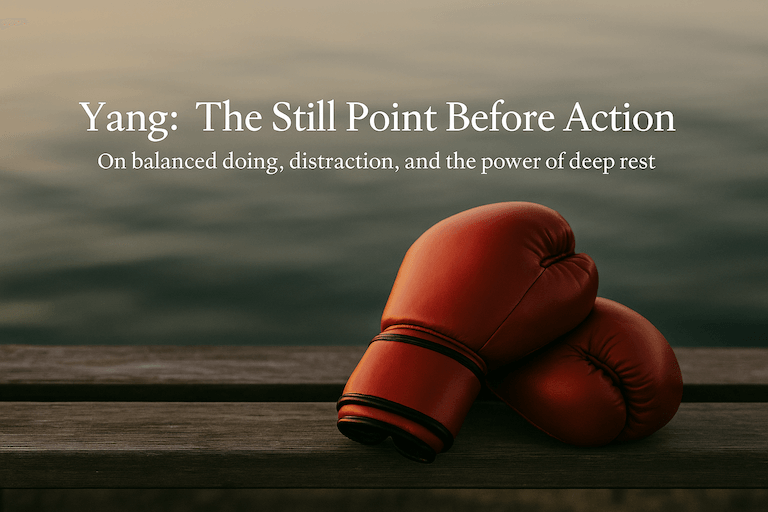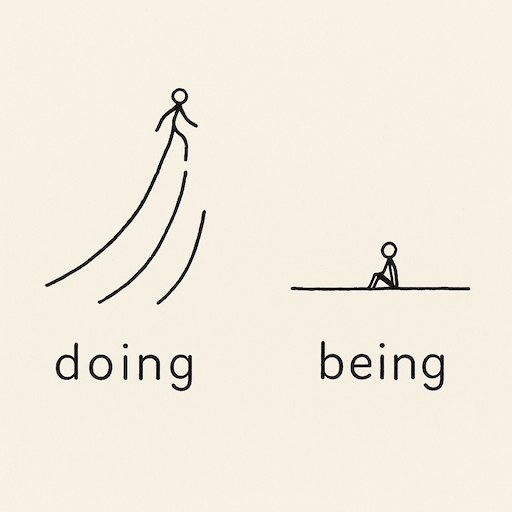Finding rest inside action
The easiest way to check your state is to notice your breathing.
This week we’re exploring doing energy that’s in balance — not pushing, forcing, or over-exerting. Of course we’ll find ourselves in and out of balance all through the day. There’s no nervous system that’s perfectly steady, and that’s okay.
One of the biggest obstacles to balanced doing in this modern world is distraction. There’s so much tugging at our attention that we often end up frazzled, scattered, unsure what to do next — or trying to do it all at once. The big delusion of our time is that we get more done through frantic, chaotic energy. But nothing could be further from the truth.
Cal Newport writes about this in Slow Productivity, where he makes a clear case for doing more with less. If you think about how much more meaningful work you’d do if you were distracted less — that’s not pushing harder; that’s simply removing what pulls you away from what matters.
It’s all related. I often find myself doing a lot, but with more stress in the doing than is really needed. One story I carry is feeling behind. I’ve spent much of my life feeling like I have to catch up, and that belief colours my actions. Whatever I’m doing, it can feel like it’s never enough — as if I’m working through a backlog that will never end. The task becomes less about its own value and more about clearing the list.
There are many stories that attach themselves to doing. Another common one is I won’t get it right or it won’t be good enough. Just notice what comes up for you around action, doing, or performing. It’s all good material for your pages.
There’s nothing wrong with the satisfaction of crossing things off, but what counts more is how I bring myself to those tasks. More often than not, slower is faster. This racing around can feel productive, but when you look closely, much of it is wasted energy disguised as busyness.
When we strip away distractions and focus on what’s in front of us, we not only get more done but do it in a smoother, more integrated way. In that open, balanced mode, our creative and higher faculties come online. Life starts to feel less like a series of problems to fix and more like a field of movement and response.
The Stoics had this insight — that obstacles aren’t just part of the path; they are the path. The obstacle is the way. Even small glimpses of this in your day count as progress.
And how often do we look around for something that was in front of us all along?
When we move through life in a more balanced way, we tend to find those things sooner — not because they suddenly appear, but because we’re less sympathetically charged. The push itself can become counterproductive. When the body is calm, the field of awareness expands. We’re no longer seeing through the narrow lens of the sympathetic nervous system. It makes all the difference to carry a little of that openness and expansiveness with us as we move through the day.
So this week, keep writing. Keep noticing where your doing feels balanced — not holding back, not pushing forward. Notice when your writing slips into flow: what does it feel like in your body? How’s your breathing? What are the markers? How do you know when you’re more in that place?
Try the same outside of writing. Can you notice when your doing carries tension, anxiety, or worry? What story are you telling yourself then?
One common pattern is that when we hold back too much, it builds up pressure and catapults us into over-doing — that swing between inertia and overdrive. I know it well.
There’s a story about the boxer Floyd Patterson, who was known to nap in the dressing room right before title fights. Reporters would watch him sleep and later hear him talk about it — his dreams, his calm, his fear. It’s an extreme example, but it beautifully illustrates the point: how deep yin can support strong yang.
When Floyd stepped into the ring, his being came from deep rest. He could switch in a moment into full fight mode — but the difference was that he had preserved his energy. Nothing wasted in unnecessary tension. All his resources gathered, ready to give everything to the task at hand — to give his best fight.
This week, make some space to find that still point before action — to rest inside the doing. That’s the essence of balanced yang.
And maybe noticing, too, that sometimes what we’re afraid of isn’t failing, but actually arriving — finishing, succeeding, being seen.
This week, let this question from Gary Keller’s The One Thing be a kind of guiding light — a way of bringing yourself more fully to the task at hand.
“What’s the one thing I can do right now such that by doing it, everything else becomes easier or unnecessary?”
That question can become a kind of internal compass — a way of dropping out of scattered effort and into the one movement that really matters. It might lead you to the dishes, to a work task, or to the gym — nothing is too trivial. The point isn’t what you do, but whether it’s the right action for you in this moment.
And it’s an experiment — learn, adjust, and try again. Let it include a sense of playfulness. It doesn’t need to feel like the most serious thing in the world.
You might also try a simple breath practice to help regulate your doing energy —
inhaling through the nose for five seconds, exhaling through the nose for five seconds.
Do this a few times a day, even just for a few minutes. It’s a small reset that reminds the body how to return to balance.
I’ll end with one of my favourite ideas from Suleika Jaouad:
“Let your survival be a creative act.”


